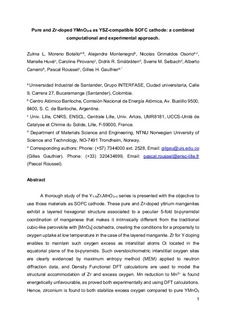| dc.contributor.author | Botello, Zulma L. Moreno | |
| dc.contributor.author | Montenegro, Alejandra | |
| dc.contributor.author | Osorio, Nicolas Grimaldos | |
| dc.contributor.author | Huve, Marielle | |
| dc.contributor.author | Pirovano, Caroline | |
| dc.contributor.author | Småbråten, Didrik Rene | |
| dc.contributor.author | Selbach, Sverre Magnus | |
| dc.contributor.author | Caneiro, Alberto | |
| dc.contributor.author | Roussel, Pascal | |
| dc.contributor.author | Gauthier, Gilles H. | |
| dc.date.accessioned | 2020-01-21T13:22:32Z | |
| dc.date.available | 2020-01-21T13:22:32Z | |
| dc.date.created | 2019-09-06T13:31:59Z | |
| dc.date.issued | 2019 | |
| dc.identifier.citation | Journal of Materials Chemistry A. 2019, 7 (31), 18589-18602. | nb_NO |
| dc.identifier.issn | 2050-7488 | |
| dc.identifier.uri | http://hdl.handle.net/11250/2637264 | |
| dc.description.abstract | A thorough study of the Y1−xZrxMnO3+δ series is presented with the objective to use these materials as SOFC cathodes. These pure and Zr-doped yttrium manganites exhibit a layered hexagonal structure similar to a peculiar 5-fold bipyramidal coordination of manganese that makes them intrinsically different from the traditional cube-like perovskite with [MnO6] octahedra, creating the conditions conducive for oxygen uptake at a low temperature in the case of the layered manganite. Zr for Y doping enables the maintenance of oxygen excess such as interstitial oxygen atoms (Oi) located in the equatorial plane of the bi-pyramids. These over-stoichiometric interstitial oxygen sites are clearly evidenced by the maximum entropy method (MEM) applied to neutron diffraction data, and density functional theory (DFT) calculations are used to model the structural accommodation of Zr and excess oxygen. Mn reduction to Mn2+ is found to be energetically unfavourable, as proved both experimentally and by DFT calculations. Hence, zirconium is found to both stabilize the excess oxygen compared to pure YMnO3 and possibly provide an oxygen ion migration path with a lower energy barrier. The main consequence is a possible MIEC behaviour in Zr-doped YMnO3, as suggested by both the conductivity measurements and theoretical calculations. The initial EIS measurements are very promising and raise the series and its original structure to the rank of materials of interest for application as SOFC electrodes. | nb_NO |
| dc.language.iso | eng | nb_NO |
| dc.publisher | Royal Society of Chemistry | nb_NO |
| dc.title | Pure and Zr-doped YMnO3+δ as a YSZ-compatible SOFC cathode: a combined computational and experimental approach | nb_NO |
| dc.type | Journal article | nb_NO |
| dc.type | Peer reviewed | nb_NO |
| dc.description.version | acceptedVersion | nb_NO |
| dc.source.pagenumber | 18589-18602 | nb_NO |
| dc.source.volume | 7 | nb_NO |
| dc.source.journal | Journal of Materials Chemistry A | nb_NO |
| dc.source.issue | 31 | nb_NO |
| dc.identifier.doi | 10.1039/C9TA04912F | |
| dc.identifier.cristin | 1722309 | |
| dc.relation.project | Notur/NorStore: ntnu243 | nb_NO |
| dc.relation.project | Notur/NorStore: NN9264K | nb_NO |
| dc.relation.project | Norges forskningsråd: 231430 | nb_NO |
| dc.relation.project | Notur/NorStore: NTNU243 | nb_NO |
| dc.description.localcode | © 2019. This is the authors' accepted and refereed manuscript to the article. The final authenticated version is available online at: http://dx.doi.org/10.1039/C9TA04912F | nb_NO |
| cristin.unitcode | 194,66,35,0 | |
| cristin.unitname | Institutt for materialteknologi | |
| cristin.ispublished | true | |
| cristin.fulltext | postprint | |
| cristin.qualitycode | 1 | |
